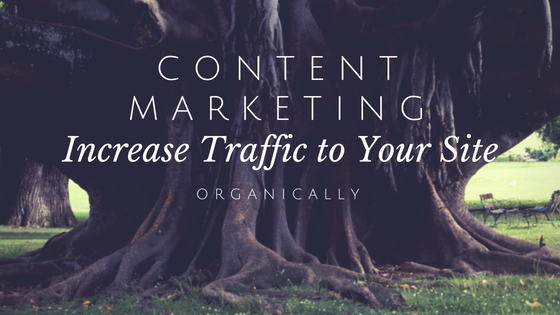Increasing Traffic to Your Website

Without Paying for Ads
While paying for Google Adwords, Facebook Ads and boosting posts can help get traffic to your website, it’s important to first invest the time to create relevant and interesting content for your current and potential customers on a consistent basis. Then when you pay to get visitors to your site, they’ll have something great to read. Paid traffic requires a strategy, the creation of ads, and the corresponding landing pages, plus methods of capturing information. This is often referred to as digital marketing.
But there is another way to get visitors to your site without making an investment in digital marketing. It’s called content marketing, and it uses content, like blog posts to attract visitors to your site. These visitors are known as organic traffic. Think of them as visitors that stop by “naturally”.
How does Content Marketing Get Me Organic Traffic?
This is a great question and I get it quite a bit. Creating meaningful and relevant content that will interest your customers means taking the time to get to know them, learn what their problems and/or interests are, and then create high quality content that meets those problems and/or interests. If you’re on your own, or running a small business or startup, this can take quite a bit of your time but it is crucial to your success in finding customers online – or should we say, enabling them to find you.
When a user types or speaks a phrase into Google, the search engine will pull up a list of relevant results. You want your pages to show up in this list for your customers. Which means that you need to know what kind of things they are asking on search engines – so that you can create content that meets their search. Creating content is no longer a one and done kind of thing. Google rates all of the content that it can pull for a search engine results page. The newer the content is, the more specific the content is, the more images and meta (behind the page) data there is, the higher it will rank in that list of results. This can be the difference between appearing on the 20th page of results or the first page.
Let’s use me as an example. And for the sake of this exercise, let’s say I’m looking for daycare for my dog Murphy. I’d probably wonder if there is a place nearby. So I’m going to include the North Hills or Allison Park in my search.
I’d also want something supervised, because Murphy likes to wrestle other dogs.
And bonus points for if there is a web cam – so I can see him and make sure that he’s OK.
So what might my search look like? It might be something like:
“Dog Daycare in Allison Park with webcam”
Or
“Accredited dog daycare in Allison Park”
Or maybe even:
“Doggy Daycare’s with video feed”
Now let’s say that you are the owner of a local dog daycare center, with trained and experienced staff, web cams and enrichment services for pets and pet owners like me. You need to have all of this in the content on your website. It needs to be fresh and you should have some photos to go along with it.
You’re probably thinking, “What does fresh mean?” or “How frequently do I now have to update my website?”
You’ve worked hard, or partnered with someone like me to make sure that the core content of your website accurately reflect your business. Changing that can undo that hard work, or create confusion. Adding a blog to your site makes adding new content on a consistent basis, that your customers find enjoyable and meaningful a lot easier.
A blog can be updated weekly, or even daily if you have enough content. Many are easy to use, like WordPress, so that you or your employees can update the blog as needed. But here are some tips.
- Select themes or categories of content that your target customers will find interesting and relevant to both their needs and your business.
- Once you have the themes worked out, it becomes easier to create specific pieces of content. You’ll want to rotate through the categories with your blog posts so that you are providing an array of content for your customers.
- Grab a calendar (I use the printable templates) and plan out your content, using your different categories for the month. It will save time, and allow you to write more than one post per sitting.
- Posts should be 300 words or more – if they’re shorter, Google won’t rank them as highly.
- Blog Posts should have a Relevant picture. It should be a google quality image.
- Image and posts should contain SEO information like titles and descriptions. If you use a CMS like WordPress, SquareSpace, etc. these often have text boxes built in for this information.
- Take these posts and share them across your social media channels to help increase the potential ways your target customers might see these posts.


